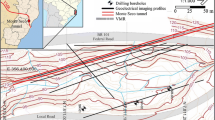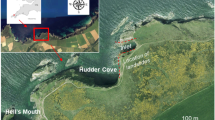Abstract
Rock slope geometry and discontinuity properties are among the most important factors in realistic rock slope analysis yet they are often oversimplified in numerical simulations. This is primarily due to the difficulties in obtaining accurate structural and geometrical data as well as the stochastic representation of discontinuities. Recent improvements in both digital data acquisition and incorporation of discrete fracture network data into numerical modelling software have provided better tools to capture rock mass characteristics, slope geometries and digital terrain models allowing more effective modelling of rock slopes. Advantages of using improved data acquisition technology include safer and faster data collection, greater areal coverage, and accurate data geo-referencing far exceed limitations due to orientation bias and occlusion. A key benefit of a detailed point cloud dataset is the ability to measure and evaluate discontinuity characteristics such as orientation, spacing/intensity and persistence. This data can be used to develop a discrete fracture network which can be imported into the numerical simulations to study the influence of the stochastic nature of the discontinuities on the failure mechanism. We demonstrate the application of digital terrestrial photogrammetry in discontinuity characterization and distinct element simulations within a slate quarry. An accurately geo-referenced photogrammetry model is used to derive the slope geometry and to characterize geological structures. We first show how a discontinuity dataset, obtained from a photogrammetry model can be used to characterize discontinuities and to develop discrete fracture networks. A deterministic three-dimensional distinct element model is then used to investigate the effect of some key input parameters (friction angle, spacing and persistence) on the stability of the quarry slope model. Finally, adopting a stochastic approach, discrete fracture networks are used as input for 3D distinct element simulations to better understand the stochastic nature of the geological structure and its effect on the quarry slope failure mechanism. The numerical modelling results highlight the influence of discontinuity characteristics and kinematics on the slope failure mechanism and the variability in the size and shape of the failed blocks.























Similar content being viewed by others
References
Brideau MA, Chauvin S, Andrieux P, Stead D (2012) Influence of 3D statistical discontinuity variability on slope stability conditions. Landslides and engineered slopes: Protecting Society through improved understanding, Banff, pp 587–593
Brown ET, Richards LR, Barr MV (1977) Shear strength characteristics of the Delabole Slates. Conference on Rock Engineering. Newcastle-upon-Tyne, UK, pp 33–51
Cai M (2011) Rock mass characterization and rock property variability considerations for tunnel and cavern design. Rock Mech Rock Eng 44(4):379–399
Cignoni P, Ranzuglia G (2014) MeshLab, a mesh processing system, for user assisted editing. Visual computing lab—ISTI-CNR
Clover AW (1978) Some aspects of the rock excavations on the western face at Delabole Slate Quarry, Cornwall. M.Sc. Thesis, Imperial College, University of London, London, UK
Coggan JS, Pine RJ (1996) Application of distinct-element modelling to assess slope stability at Delabole Slate Quarry, Cornwall, England. Transactions of the Institution of Mining and Metallurgy. Sect A. Min Ind 105:A22–A30
Coggan J, Gwynn XP, Pine RJ, Wetherelt A (2008) Rock mass characterisation: Is there a role for remote mapping techniques? Remote Sensing and Photogrammetry Society Conference, Exeter, UK
Costa M, Coggan JS, Eyre JM (1999) Numerical modelling of slope behaviour of Delabole Slate Quarry (Cornwall, UK). Int J Surf Min Reclam Environ 13(1):11–18
Cundall PA (1988) Formulation of a three-dimensional distinct element model—part I. A scheme to detect and represent contacts in a system composed of many polyhedral blocks. Int J Rock Mech Min Sci Geomech Abstr 25(3):107–116
Dershowitz WS, Herda H (1992) Interpretation of fracture spacing and intensity. In: 42nd US rock mechanics/geomechanics symposium. American Rock Mechanics Association, Santa Fe, New Mexico
Dershowitz WS, Lee G, Geier J, LaPointe P (2014) FracMan: interactive discrete feature data analysis, geometric modeling and exploration simulation. Golder Associates Inc, USA
Dick GJ, Eberhardt E, Stead D, Rose ND (2013) Early detection of impending slope failure in open pit mines using spatial and temporal analysis of real aperture radar measurements. Slope Stability 2013. Australian Centre for Geomechanics, pp 949–962
Einstein HH, Baecher GB (1983) Probabilistic and statistical methods in engineering geology. Rock Mech Rock Eng 16(1):39–72
Elmo D (2006) Evaluation of a hybrid FEM/DEM approach for determination of rock mass strength using a combination of discontinuity mapping and fracture mechanics modelling, with particular emphasis on modelling of jointed pillars. University of Exeter, Exeter
Elmo D, Stead D (2010) An integrated numerical modelling–discrete fracture network approach applied to the characterisation of rock mass strength of naturally fractured pillars. Rock Mech Rock Eng 43(1):3–19
Eyre ML, Pascoe D, Patrick F, Coggan J (2014) Digital data acquisition for effective slope management. In: 22nd UK Conference of the Association for Computational Mechanics in Engineering. Exeter, UK
Fekete S, Diederichs M (2013) Integration of three-dimensional laser scanning with discontinuum modelling for stability analysis of tunnels in blocky rockmasses. Int J Rock Mech Min Sci 57:11–23
Firpo G, Salvini R, Francioni M, Ranjith PG (2011) Use of digital terrestrial photogrammetry in rocky slope stability analysis by distinct elements numerical methods. Int J Rock Mech Min Sci 48(7):1045–1054
Freshney EC (1972) Geology of the coast between Tintagel and Bude: (Explanation of part of one-inch geological sheet 322, new series). Her Majesty’s Stationery Office, London
Gao F (2013) Simulation of failure mechanisms around underground coal mine openings using discrete element modelling. Ph.D. Thesis, Simon Fraser University, Burnaby, Canada
Geosystems Leica (2010) Leica Cyclone; 3D point cloud processing software. Leica Geosystems HDS, Heerbrugg
Havaej M, Stead D, Lorig L, Vivas J (2012) Modelling rock bridge failure and brittle fracturing in large open pit rock slopes. In: 46th US Rock Mechanics/Geomechanics Symposium. American Rock Mechanics Association, Chicago, Illinois
Havaej M, Stead D, Mayer J, Wolter A (2014) Modelling the relation between failure kinematics and slope damage in high rock slopes using a lattice scheme approach. In: 48th US Rock Mechanics/Geomechanics Symposium. American Rock Mechanics Association, Minneapolis, Minnesota
Havaej M, Wolter A, Stead D (2015) Exploring the potential role of brittle rock fracture in the 1963 Vajont Slide, Italy. In: International Journal of Rock Mechanics and Mining Sciences (submitted)
Itasca (1997) UDEC 3.0. manual. Itasca Consulting Group Inc., Minneapolis
Itasca (2010) Slope Model, description of formulation with verification and example problems. Revision 2. Itasca Consulting Group Inc., Minneapolis
Itasca (2014a) 3DEC-3 dimensional distinct element code user’s guide. Itasca Consulting Group Inc., Minneapolis
Itasca (2014b) KUBRIX Geo, advanced automatic and interactive grid generation for engineering software. Itasca Consulting Group Inc., Minneapolis
Leese CE, Setchell J (1937) Notes on Delabole Slate Quarry. Trans Roy Geol Soc Cornwall 17:41–47
McNeel R (2014) Rhinoceros, modelling tool for designers. McNeel North America
Mercer KG (2006) Investigation into the time dependent deformation behaviour and failure mechanisms of unsupported rock slopes based on the interpretation of observed deformation behaviour. Ph.D. Thesis, University of the Witwatersrand
Oppikofer T, Jaboyedoff M, Blikra L, Derron M-H, Metzger R (2009) Characterization and monitoring of the Åknes rockslide using terrestrial laser scanning. Nat Hazards Earth Syst Sci 9(3):1003–1019
Preston R, Roberts D, McIntire H, Stead D (2014) Use of photogrammetry and discrete fracture networks to characterize pillar damage and rock mass characteristics. In: International discrete fracture network engineering conference, Vancouver, Canada
Priest SD, Hudson JA (1981) Estimation of discontinuity spacing and trace length using scanline surveys. Int J Rock Mech Min Sci Geomech Abstr 18(3):183–197
Riggs WHH (2014) Applications of thermal imaging in mining and coastal slope stability analysis. M.Sc. Thesis, The University of Exeter, Penryn, UK
Rockfield (2009) ELFEN manual version 4.4. Rockfield Software Limited, Swansea
Rocscience (2014) Dips 6.0, graphical and statistical analysis of orientation data. Rocscince Inc., Toronto, Canada
Rogers S, Moffitt K, Kennard DT (2006) Probabilistic slope and tunnel block stability analysis using realistic fracture network models. In: Golden rocks 2006. The 41st US Symposium on Rock Mechanics (USRMS)
Rogers S, Elmo D, Webb G, Catalan A (2014) Volumetric fracture intensity measurement for improved rock mass characterisation and fragmentation assessment in block caving operations. Rock Mech Rock Eng:1–17
Rosthorn JL (1991) A stability assessment of the footwall slope of Delabole Quarry. M.Sc. Thesis, The University of Exeter, Penryn, UK
Salvini R, Giovannini R, Vanneschi C, Riccucci S, Francioni M, Stead D (2014) The use of remote sensing for discontinuity mapping and analysis in a large marble quarry, Carrara, Italy. In: International discrete fracture network engineering conference, Vancouver, Canada
Selwood EB, Thomas JM, Williams BJ, Clayton RE, Durning B, Smith O, Warr LN (1998) Geology of the country around Trevose Head and Camelford. British Geological Society
Shillitto DA (2013) Delabole Quarry—geotechnical assessment and pit design of the north east sector. M.Sc. Thesis, The University of Exeter, Penryn, UK
Staub I, Fredriksson A, Outters O (2002) Strategy for a rock mechanics site descriptive model development and testing of the theoretical approach. Swedish Nuclear Fuel and Waste Management Co, Stockholm, Sweden
Sturzenegger M, Stead D (2009a) Quantifying discontinuity orientation and persistence on high mountain rock slopes and large landslides using terrestrial remote sensing techniques. Nat Hazards Earth Syst Sci 9(2):267–287
Sturzenegger M, Stead D (2009b) Close-range terrestrial digital photogrammetry and terrestrial laser scanning for discontinuity characterization on rock cuts. Eng Geol 106(3–4):163–182
Sturzenegger M, Yan M, Stead D, Elmo D (2007) Application and limitations of ground-based laser scanning in rock slope characterization. American Rock Mechanics Association, Vancouver, pp 29–36
Styles TD, Zhang Y, Stead D (2010) A photogrammetric approach to brittle fracture characterization in mine pillars. In: 44th US Rock Mechanics/Geomechanics Symposium. American Rock Mechanics Association, Salt Lake City
Technology ADAM (2014) 3DM Analyst Mine Mapping Suite. ADAM Technology, Belmont
Tuckey Z (2012) An integrated field mapping-numerical modelling approach to characterising discontinuity persistence and intact rock bridges in large open pit slopes. M.Sc. Thesis, Simon Fraser University, Burnaby, Canada
Tuckey Z, Stead D, Havaej M, Gao F, Sturzenegger M (2012) Towards an integrated field mapping-numerical modelling approach for characterising discontinuity persistence and intact rock bridges in large open pits. The Canadian Geotechnical Society (Geo Manitoba), Winnipeg Manitoba
Vyazmensky A, Stead D, Elmo D, Moss A (2010) Numerical analysis of block caving-induced instability in large open pit slopes: a finite element/discrete element approach. Rock Mech Rock Eng 43(1):21–39
Wolter A (2014) Characterisation of large catastrophic landslides using an integrated field, remote sensing and numerical modelling approach. Ph.D. Thesis, Simon Fraser University, Burnaby, Canada
Xu C, Dowd P (2010) A new computer code for discrete fracture network modelling. Comput Geosci 36(3):292–301
Zavodni ZM, Broadbent CD (1980) Slope failure kinematics. Bull Can Inst Min Can Inst Min Metall 73:69–74
Acknowledgments
The authors would like to thank George Hamilton from the Delabole Slate Company Ltd for access to Delabole Quarry. The authors would also like to thank Charlie Matthews from Leica™ Geosystems for undertaking laser scanning and data processing allowing the authors to carry out geomechanical interrogation and analysis.
Author information
Authors and Affiliations
Corresponding author
Rights and permissions
About this article
Cite this article
Havaej, M., Coggan, J., Stead, D. et al. A Combined Remote Sensing–Numerical Modelling Approach to the Stability Analysis of Delabole Slate Quarry, Cornwall, UK. Rock Mech Rock Eng 49, 1227–1245 (2016). https://doi.org/10.1007/s00603-015-0805-z
Received:
Accepted:
Published:
Issue Date:
DOI: https://doi.org/10.1007/s00603-015-0805-z




